- More top-rated seats help parents make a safe choice for their kids
How common are child passenger deaths? Motor vehicle crashes are the leading cause of death for children age 3 and older. A total of 1,062 children younger than age 13 died in motor vehicle crashes in 2009; more than 750 of these deaths were children riding in passenger vehicles.
The number of child passenger deaths has declined by half since 1975. The rate of child passenger deaths per million children also has fallen dramatically to 14 deaths per million children in 2009, a 54 percent reduction from 1975.
Proper restraint use can help reduce deaths even more. The proportion of fatally injured children who were restrained rose from 15 percent in 1985 to 54 percent in 2009. Still, nearly 300 fatally injured child occupants were unrestrained in 2009, and others were improperly restrained.
Booster Seat evaluations
A good fit is easier than ever to find when shopping for a booster seat, new ratings from the Insurance Institute for Highway Safety show.
A record 31 seats have been designated Best Bets, meaning they correctly position a vehicle safety belt on a typical 4 to 8 year-old in almost any car, minivan, or SUV. Prices for these top-rated seats range from less than $15 to several hundred dollars. In addition to the 31 Best Bets, another 5 seats are Good Bets, meaning they provide acceptable belt fit in most vehicles. Six boosters are not recommended because they don’t provide proper belt fit, and consumers are advised to avoid them (see list below).
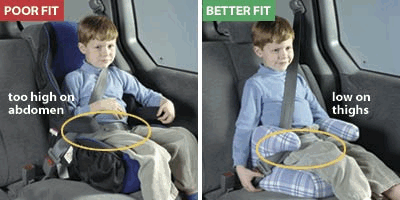
Booster seats can improve the fit of adult belts for children who have outgrown child restraints, but not all boosters provide the recommended belt fit. It’s important to ensure that the lap belt fits low across the upper thigh, not across the child’s soft abdomen. The shoulder belt should cross snuggly over the center of the shoulder.

Booster seats are for children who have outgrown forward-facing child restraints. A booster should elevate a child and route the lap and shoulder belts, which are designed for adults, in the correct position to restrain a child during a crash. Some boosters do this better than others. The problem is that consumers can’t tell a good booster from a bad one just by comparing features or prices. The Institute’s booster seat ratings, initiated in 2008, are the only evaluations to tell parents which boosters do the best job of improving belt fit for children in the widest range of vehicles.
“A Best Bet means any of these top-rated boosters should work well in the family SUV or the babysitter’s sedan,” says Anne McCartt, the Institute’s senior vice president for research.
Engineers evaluated 62 booster models in the latest round. Twenty-one of them show up twice in the lists. These are dual-use seats, which can work as highback or backless boosters. In the ratings, each dual-use model is considered to be 2 separate boosters for a total of 83 seats evaluated, 11 more than last year.
The biggest group of boosters falls into a middle category, designated “check fit.” These 41 seats may provide good fit for some children in some vehicles, but not as many as Good Bets or Best Bets. Parents are advised to make sure the lap belt lies flat across a child’s upper thighs and the shoulder belt crosses snugly over the middle of the shoulder. If not, a different seat is needed.
The focus of the Institute’s ratings is belt fit, not crash performance, and no crash tests are conducted as part of the evaluation. To assess belt fit, engineers use a test dummy representing an average-size 6 year-old. They measure how lap and shoulder belts fit the dummy in each booster under 4 conditions representing the range of belt configurations in real-world vehicles.
Improvements and innovations: Boosters have improved a lot in recent years. In 2008 there were 10 Best Bets. That fell to 9 in 2009 but soared to 21 last year after manufacturers began using the Institute’s test protocols as they designed and updated their seats.
“Just 4 years into our ratings program, parents have a wide variety of top-rated seats to choose from,” McCartt says. “Still, boosters that don’t consistently provide good belt fit outnumber the ones that do, so consumers need to keep paying attention to this issue.”
Boosters elevate children and position safety belts so the belts will fit them better. The lap belt should lie flat and on top of a child’s upper thighs, not higher up on the abdomen. The shoulder belt should fit across the middle of a child’s shoulder. If it falls off the shoulder or rests on the neck, a child might move the belt behind the back or under an arm.
One thing consumers need to be aware of is that most dual-use boosters have different ratings for each mode. For example, 14 dual-use boosters are Best Bets or Good Bets in highback mode but are designated check fit in backless mode. For one seat, the Evenflo Big Kid Sport, the opposite is true: It’s a Best Bet in backless mode and a check fit in highback mode.
The Harmony Dreamtime remains the only dual-use booster that’s a Best Bet in both modes, while the Combi Kobuk Air Thru is a Good Bet in both modes.
A notable newcomer to the Best Bet list is the BubbleBum, an inflatable seat that’s marketed for vacations, car pools, and taxis, as well as everyday use. When needed, it can be quickly inflated by blowing into a valve at the back of the seat.
Among booster manufacturers, Harmony Juvenile Products continues to be a standout. All 5 seats the Canadian company currently makes, counting the Dreamtime in both modes, are Best Bets. The company is discontinuing the dual-use Baby Armor, which was a Best Bet in highback mode but not recommended in backless mode.
Small change, big difference: Diono, which recently changed its name from Sunshine Kids, bumped an existing seat, the Monterey, from check fit to Best Bet by changing the shoulder belt guide. The new ranking applies when the dual-use seat is used in highback mode. The booster remains a “check fit” in backless mode. Consumers should look for Montereys manufactured after July 2011 to ensure they are getting the newer version.
Meanwhile, the Evenflo Symphony 65, which has been a Good Bet since 2009, now has a sister seat, the Symphony 65 e3. It has a slightly different shoulder belt guide, and that makes enough of a difference to make it a Best Bet.
“Booster manufacturers often use similar names for different seats or, in the case of the redesigned Monterey, even the same names,” McCartt says. “It’s important for consumers to look at model numbers and manufacture dates when consulting our ratings.”
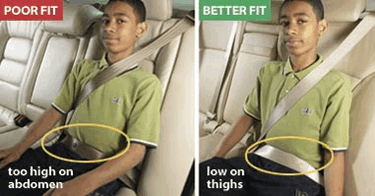
Adult belts – When older children start using the vehicle belts, the shoulder belt should rest across the chest, away from the neck, and the lap belt should fit low and snug across the upper thigh. Your child needs to sit straight up with knees bent at the edge of the seat.
Proper fit is key
ratings identify boosters most likely to provide good lap and shoulder belt fit. Safety belts are designed with adults in mind, not kids, but when a booster seat is doing its job, the vehicle belt will fit a child correctly. That means the lap belt willl lie flat across a child’s upper thighs, not across the soft abdomen, and the shoulder belt will cross snugly over the middle of a child’s shoulder.
The Institute puts the booster seats it tests into 4 categories:
- BEST BETS are seats that provide good fit for typical 4 to 8 year-olds in almost any vehicles
- GOOD BETS provide acceptable fit in most cars, minivans, or SUVs.
- Not recommended don’t provide good fit and should be avoided.
Check fit applies to booster seats the Institute has tested that have varied results depending on child size and vehicle model.
Checking booster fit
Both the lap and shoulder belts must fit your child correctly.
Lap belt fit — The lap belt should lie flat and on top of the thighs, not higher up on the abdomen
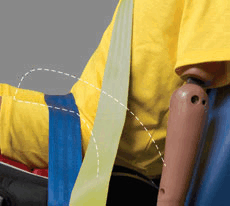
Good lap belt fit (above)
outline = arm rest removed to show belt position
Poor lap belt fit (below)
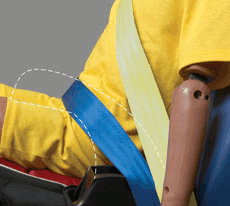
Shoulder belt fit — The shoulder belt should fit across the middle of the child’s shoulder. If it falls off the shoulder or rests on your child’s neck, it won’t work as well. An improper fit could encourage your child to move the belt to a dangerous position, such as behind the back or under the arm.
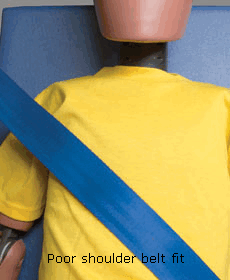
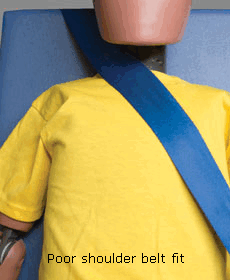
2011 IIHS BOOSTER EVALUATION RESULTS
Best Bets
Britax Frontier 85
Britax Frontier 85 SICT
Britax Parkway SGL (highback mode)
BubbleBum
Chicco KeyFit Strada (highback mode)
Clek Oobr (highback mode)
Cosco Pronto (highback mode)
Cybex Solution X-Fix
Diono/Sunshine Kids Monterey (highback mode)
Eddie Bauer Auto Booster (highback mode)
Evenflo Big Kid Amp
Evenflo Big Kid Sport (backless mode)
Evenflo Maestro
Evenflo Symphony 65 e3
Ferrari Dreamway SP (highback mode)
Graco Argos 70 (highback mode)
Graco TurboBooster – Baldwin (highback mode)
Graco TurboBooster Elite (highback mode)
Harmony Cruz Youth Booster/Harmony Carpooler
Harmony Dreamtime (backless mode)
Harmony Dreamtime (highback mode)
Harmony Olympian/Secure Comfort Deluxe
Harmony Youth Booster Seat
Kids Embrace Dale Earnhardt Jr.
Maxi-Cosi Rodi XR (highback mode)
Recaro ProBOOSTER
Recaro ProSPORT
Recaro Vivo
Safety 1st Boost Air Protect (highback mode)
Safety 1st S1 Rümi Air
The First Years B570 Pathway
View Images for Best Bets
Good Bets
Britax Parkway SG (highback mode)
Combi Kobuk Air Thru (backless mode)
Combi Kobuk Air Thru (highback mode)
Evenflo Symphony 65
Maxi-Cosi Rodi (highback mode)
NOT RECOMMENDED
Evenflo Chase
Evenflo Express
Evenflo Generations 65
Evenflo Sightseer
Safety 1st All-in-One
Safety 1st Alpha Omega Elite
View Images for Not Recommended
Note: Forty-one boosters are designated “check fit.” They may provide adequate belt fit for some kids in some vehicles.

You must be logged in to post a comment.